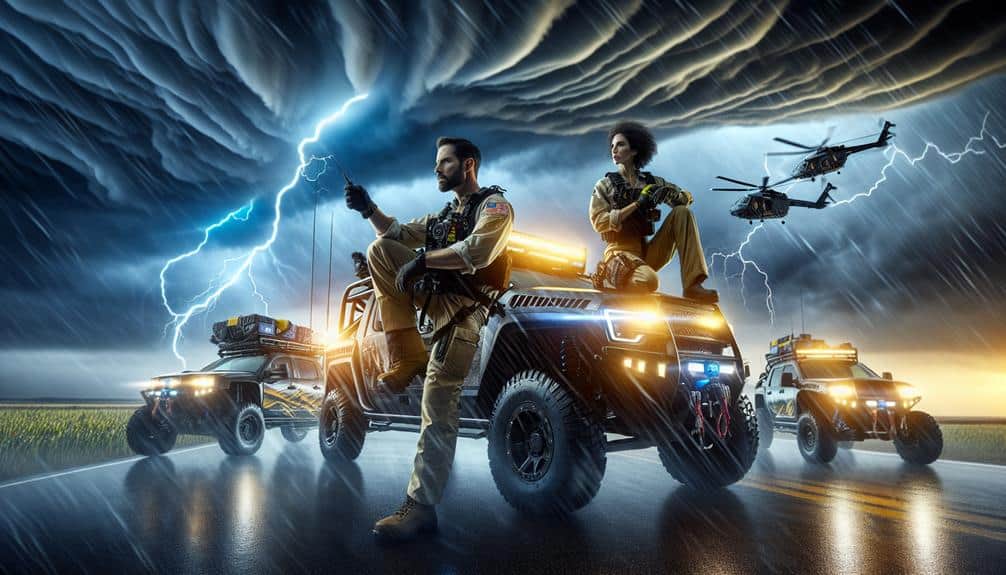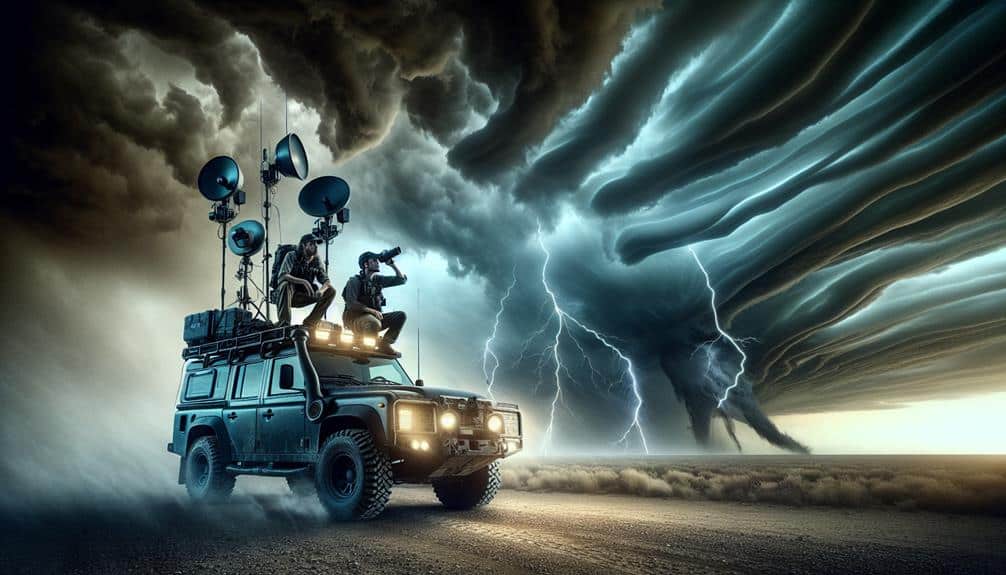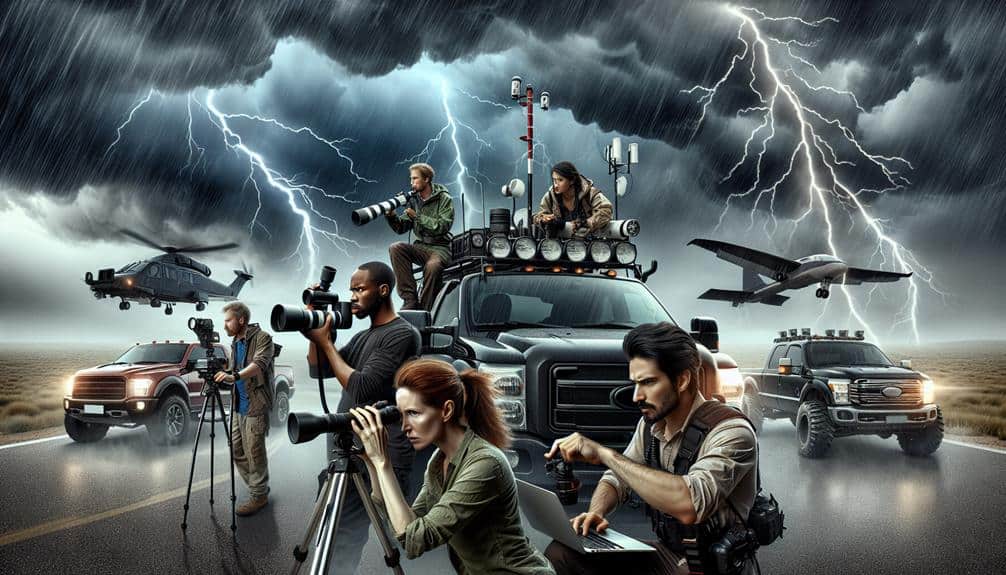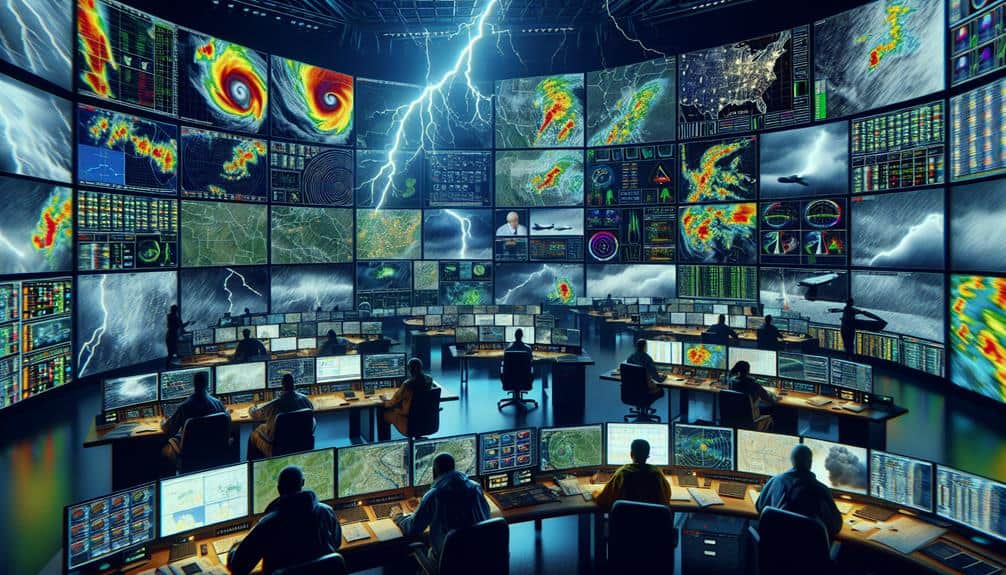We engage in unforgettable storm chasing tours in Tornado Alley, traversing Texas, Oklahoma, Kansas, Nebraska, and South Dakota during peak tornado season from April to June. Led by experienced meteorologists from top companies like Tempest Tours, we use advanced equipment to monitor real-time atmospheric conditions, predicting and safely intercepting supercells. Safety is paramount; we undergo rigorous training, maintain essential gear including GPS and anemometers, and follow detailed emergency protocols. Our adventures offer a rare glimpse into severe weather dynamics, ensuring an exhilarating yet secure experience. Discover the awe-inspiring power of nature with us and expand your storm-chasing knowledge.
Key Points
- Experienced meteorologist guides offer real-time data interpretation for accurate storm predictions.
- Advanced equipment and tools ensure safe and effective storm chasing.
- Tours provide comprehensive safety briefings and emergency preparedness.
- Early booking ensures participation with reputable operators who offer educational insights.
Popular Storm Chase Routes
Among the most popular storm chase routes, Tornado Alley stands out due to its high frequency of severe thunderstorms and tornadoes. Stretching across parts of Texas, Oklahoma, Kansas, Nebraska, and South Dakota, this region offers unparalleled opportunities to witness nature's fury.
We find ourselves drawn to these stormy landscapes, where the atmospheric conditions are ripe for supercell formation, leading to awe-inspiring tornadoes.
Our journey through Tornado Alley isn't just about the thrill of the chase; it's a data-driven adventure. Meteorological data indicates that peak tornado activity occurs from April to June, making this the best window for storm chasers.
The combination of cold, dry air from Canada meeting warm, moist air from the Gulf of Mexico generates the extreme weather patterns we're excited to observe.
The extreme adrenaline rush we experience is unmatched. Each chase brings the possibility of witnessing the raw power of a tornado, maneuvering mesocyclones, and studying the complex interactions within storm cells.
Our freedom to explore these dramatic weather events is fueled by a passion for understanding and experiencing the science behind them. In Tornado Alley, every storm is a new chapter in our quest for knowledge and excitement.
Top Tour Companies
Let's examine the leading storm chasing tour companies, focusing on their expert-led adventures and rigorous safety protocols.
We'll assess how they train their guides and guarantee participant safety.
Expert-Led Adventures
We recommend Tempest Tours and Storm Chasing Adventure Tours for their data-driven approach and experienced meteorologist guides. Their commitment to scientific accuracy and precise storm tracking makes these tours stand out.
Utilizing advanced techniques, they monitor atmospheric conditions with state-of-the-art equipment, ensuring we're always in the best possible position to witness nature's most powerful phenomena.
Tempest Tours employs meteorologists skilled in interpreting real-time data. They use radar, satellite imagery, and sophisticated weather models to predict storm development and movement with remarkable accuracy. This meticulous approach not only enriches our understanding but also maximizes our chances of encountering awe-inspiring weather events.
Similarly, Storm Chasing Adventure Tours leverages cutting-edge technology and expert knowledge to provide a thrilling yet educational experience. Their guides, often seasoned storm chasers themselves, bring a wealth of practical expertise. They offer insights into the dynamics of severe weather, enhancing our appreciation of the forces at play.
Safety and Training
Safety and training are paramount for top storm chasing tour companies, ensuring both exciting experiences and our well-being. These companies employ advanced techniques to monitor storm systems in real-time, using state-of-the-art radar and satellite data to predict storm paths with high precision. Our guides are trained meteorologists with extensive field experience, equipped to make informed decisions for each chase.
Emergency procedures are meticulously planned and rehearsed. In case of sudden weather changes, we've predefined escape routes and communication protocols to guarantee everyone's safety. We carry essential emergency equipment, including first aid kits, GPS devices, and two-way radios, to handle unforeseen situations effectively.
Additionally, all participants receive a detailed safety briefing before the tour begins. This briefing covers the basics of storm behavior, the importance of following guide instructions, and what to do in emergency scenarios. By adhering to these safety measures, we can immerse ourselves in the awe-inspiring power of nature while minimizing risk.
Our commitment to safety and thorough training enables us to experience the exhilaration of storm chasing without compromising our well-being. We believe that understanding and respecting the forces of nature enhances our sense of freedom and adventure.
Essential Gear Checklist

To guarantee a successful storm chasing journey, it's crucial to equip ourselves with a comprehensive checklist of essential gear. First and foremost, proper gear maintenance ensures our equipment is reliable and ready for intense conditions. Our cameras and lenses for storm photography must be in top condition to capture those breathtaking moments. Regular checks and cleaning are non-negotiable.
For direction tools, we rely on GPS devices and detailed weather radar apps to track storm movements accurately. A high-quality anemometer is essential for measuring wind speeds, providing real-time data crucial for our observations.
Emergency supplies are another foundation of our checklist. We need a well-stocked first aid kit, extra batteries, a portable weather radio, and non-perishable food. A multipurpose tool and a durable flashlight with spare batteries are also necessary for unforeseen situations.
In addition, our clothing must be practical for quick weather changes. Waterproof jackets, sturdy boots, and thermal layers ensure we stay dry and warm.
Lastly, a reliable vehicle equipped with all-terrain tires and emergency repair kits is crucial for navigating challenging terrains safely.
Safety Tips for Chasers
To guarantee our safety while storm chasing, we need to follow a thorough gear checklist and adopt effective weather awareness strategies.
It's essential to have reliable communication devices, first aid kits, and GPS systems.
Additionally, we must constantly monitor meteorological data and understand storm behavior patterns.
Essential Gear Checklist
Proper preparation involves a thorough gear checklist to guarantee our safety and effectiveness while storm chasing. First, gear maintenance is paramount. Regularly inspect our vehicle and make sure all systems are functioning at their best. Carry essential emergency supplies, including a first aid kit, road flares, and a multi-tool. These items can be lifesavers in unexpected situations.
Next, let's not forget our camera equipment. High-resolution cameras with sturdy tripods allow us to capture the majesty of storms with scientific precision. Extra batteries and memory cards are essential to avoid interruptions.
Equally important are our communication devices. Reliable mobile phones, two-way radios, and mobile hotspots ensure we stay connected with our team and emergency services.
Additionally, personal protective equipment (PPE) like helmets, goggles, and sturdy boots can shield us from debris and other hazards. Reflective vests enhance visibility, especially during low-light conditions.
By adhering to this gear checklist, we not only promote our safety but also maximize our ability to document and study storm phenomena.
As freedom-seekers, this preparation empowers us to explore nature's most dramatic displays while minimizing risks. Let's embrace this meticulous approach to make sure every storm chasing adventure is both thrilling and safe.
Weather Awareness Strategies
We must consistently monitor weather forecasts and real-time data to anticipate storm developments and adjust our plans accordingly. This vigilance is pivotal in securing our safety and optimizing our storm-chasing experience.
Utilizing advanced meteorological tools, like Doppler radar and satellite imagery, allows us to track storm systems with precision. It's crucial that we stay informed through credible sources such as the National Weather Service and specialized storm-chasing apps.
Emergency preparedness is non-negotiable. We need to have a well-thought-out plan that includes predefined escape routes and communication strategies. Equip our vehicles with essential emergency supplies, including first aid kits, flashlights, and weather radios.
Understanding storm dynamics through meteorological education can greatly enhance our decision-making skills in rapidly changing environments. Knowledge of how supercells and tornadoes form, for example, helps us identify potential threats early.
Let's not forget the importance of teamwork. Constant communication within our group ensures everyone is aware of any changes in weather patterns or plans. Using precise terminology when relaying information can prevent misunderstandings and guarantee swift action.
Real-Life Chasing Stories

Amidst the adrenaline and awe of storm chasing, we've documented several remarkable real-life stories that highlight the unpredictable nature of severe weather phenomena. One unforgettable chase occurred in Tornado Alley, where we observed a supercell that rapidly intensified from a benign cumulus cloud to a full-blown tornado within minutes. The sheer speed of transformation left us awestruck and reminded us of the inherent uncertainty in predicting storm behavior.
During another chase in Oklahoma, we encountered a multi-vortex tornado that defied conventional storm models. The system displayed erratic motion patterns, complicating our pursuit and underscoring the necessity for real-time data interpretation. We relied heavily on Doppler radar data and mobile mesonets to adapt our strategy on the fly, which provided an unparalleled adrenaline rush.
In Kansas, a seemingly standard thunderstorm evolved into a massive derecho, characterized by hurricane-force winds and widespread damage. This event was a stark example of the volatile nature of mesoscale convective systems. We collaborated with meteorologists to analyze the atmospheric conditions that led to such an intense event, gaining insights that enhanced our future chases.
These stories aren't just thrilling; they offer invaluable lessons about the capricious dynamics of severe weather.
Booking Your Adventure
When booking your storm chasing adventure, it's crucial to take into account several factors to guarantee a safe and scientifically enriching experience. First, we should consider early reservations. Securing a spot early not only guarantees participation but also grants us access to the most reputable tour operators who prioritize safety and scientific accuracy.
Furthermore, understanding the logistics of the trip is vital. We need to scrutinize the experience level of the guides, their grasp of meteorological data, and the technology they employ to track storms.
Here are some key considerations:
- Early reservations: Booking in advance often provides us with better options and ensures we don't miss the peak storm season.
- Group discounts: Many operators offer discounts for groups, which can make the experience more affordable and enjoyable when shared with friends or family.
- Safety protocols: Verify that the tour operator has strict safety protocols and emergency procedures in place.
- Equipment quality: Make sure they use advanced tracking systems and reliable vehicles.
Frequently Asked Questions
What Is the Best Time of Year for Storm Chasing Tours?
Did you know 75% of tornadoes occur between April and June? This period offers the best locations for storm chasing. We must always follow safety precautions to guarantee thrilling, yet secure, experiences.
Are Storm Chasing Tours Suitable for Children and Families?
We prioritize safety precautions to maintain a secure environment. However, age restrictions typically apply due to the inherent risks of storm chasing. While adventurous, these tours might not be suitable for young children or families seeking a relaxed experience.
How Long Do Storm Chasing Tours Typically Last?
Storm chasing tours typically last around 7-10 days. To guarantee safety precautions, we monitor weather conditions closely. Advanced equipment needed includes radar systems and GPS units. This approach maximizes both safety and the freedom to explore.
Do I Need Prior Experience to Join a Storm Chasing Tour?
We don't need prior experience to join a storm chasing tour. Safety precautions are strictly followed, and we rely on expert guidance throughout the journey. This guarantees we gain thrilling experiences without compromising our safety.
What Kind of Transportation Is Used During Storm Chasing Tours?
In the dance of nature's fury, we use helicopter rides for aerial views and off-road vehicles for ground pursuit. These modes of transport guarantee our freedom to navigate challenging terrains and capture storm data accurately.


